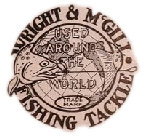

















Wiggling Shrimp
c. 1930
Listed in two sizes the Wiggling Shrimp is difficult to locate. Throw in the orange box with insert even oil stained and it's next to impossible to find such a combo. Though cataloged in one general color, other variations have surfaced.
Tarpon or Baby Whale
c. 1930
Little is known about this bait. Even the name is based on colloquial names given to it by collectors. Molded like earlier baits this bait is heavy, designed to sink. Only 3 or 4 are known to exist.
Daddy Long Legs Spider or Spider
c. 1930
Produced with rubber legs, most now are brittle, missing and or wrapped around the body. Colors included brushed bronze with black stripes down dorsal surface, rough textured blackish-bronze and the one shown here smooth finish similar to the mouse paint scheme of gray and black (only one known in this color, from the Larry Sundal collection). Not listed in the 1938 catalog.
Squid or Cuttlefish
c. 1930 ish
Little is known about this bait. Not found cataloged, even the name is based on names given to it by collectors. Molded like earlier baits this bait is large, designed to sink. Only 3 or 4 are known to exist. This example is missing much of its tentacles which were of long red and white saddle hackles. Rare.
Moss Bug
c. 1930
Designated as a fly rod bait, it is hard to imagine casting this bait with a fly rod due to size and weight. The large MB1 size measures a whopping 2 1/2 inches. The smaller size MB2 can be found in two color configurations. one enameled green wings or like the one shown here with natural color brown gray feathered wings. The later version seen here on the card is of cork and has little resemblance to the original, being confused with the Ozark Bug. Rare.

Willow Fly
c. 1934-36
This gem was intended to mimic the adult species of the Western Stone Fly though early advertising seem to have it confused with the hatch of the Hellgramite. Cork bodied with glass eyes; the feather-winged bug is very rare. (background source NFLCC article winter 2014 issue, Jim Dorr & Jerry Martin)

Lucky Bug
c. Unkn
This commonly found bait has been found carded but never listed or illustrated in any catalog or advertisement. Originally with red rubber legs threaded through the body, all examples known have had the legs ablated away.